ABS KIA CADENZA 2020 Owners Manual
[x] Cancel search | Manufacturer: KIA, Model Year: 2020, Model line: CADENZA, Model: KIA CADENZA 2020Pages: 560, PDF Size: 11.37 MB
Page 170 of 560
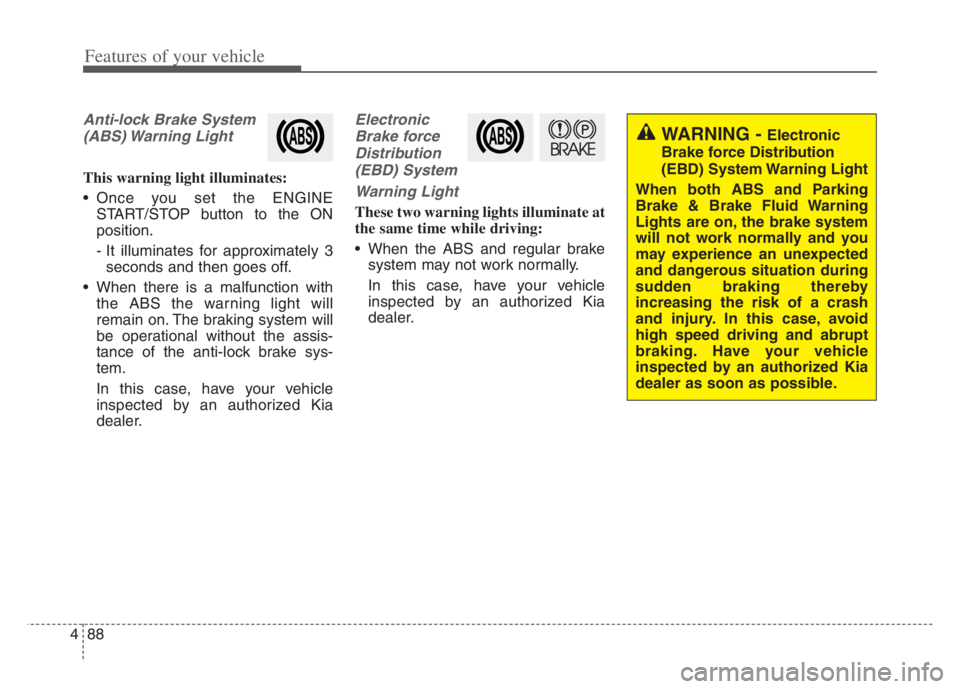
Features of your vehicle
88 4
Anti-lock Brake System
(ABS) Warning Light
This warning light illuminates:
Once you set the ENGINE
START/STOP button to the ON
position.
- It illuminates for approximately 3
seconds and then goes off.
When there is a malfunction with
the ABS the warning light will
remain on. The braking system will
be operational without the assis-
tance of the anti-lock brake sys-
tem.
In this case, have your vehicle
inspected by an authorized Kia
dealer.
Electronic
Brake force
Distribution
(EBD) System
Warning Light
These two warning lights illuminate at
the same time while driving:
When the ABS and regular brake
system may not work normally.
In this case, have your vehicle
inspected by an authorized Kia
dealer.
WARNING - Electronic
Brake force Distribution
(EBD) System Warning Light
When both ABS and Parking
Brake & Brake Fluid Warning
Lights are on, the brake system
will not work normally and you
may experience an unexpected
and dangerous situation during
sudden braking thereby
increasing the risk of a crash
and injury. In this case, avoid
high speed driving and abrupt
braking. Have your vehicle
inspected by an authorized Kia
dealer as soon as possible.
Page 171 of 560
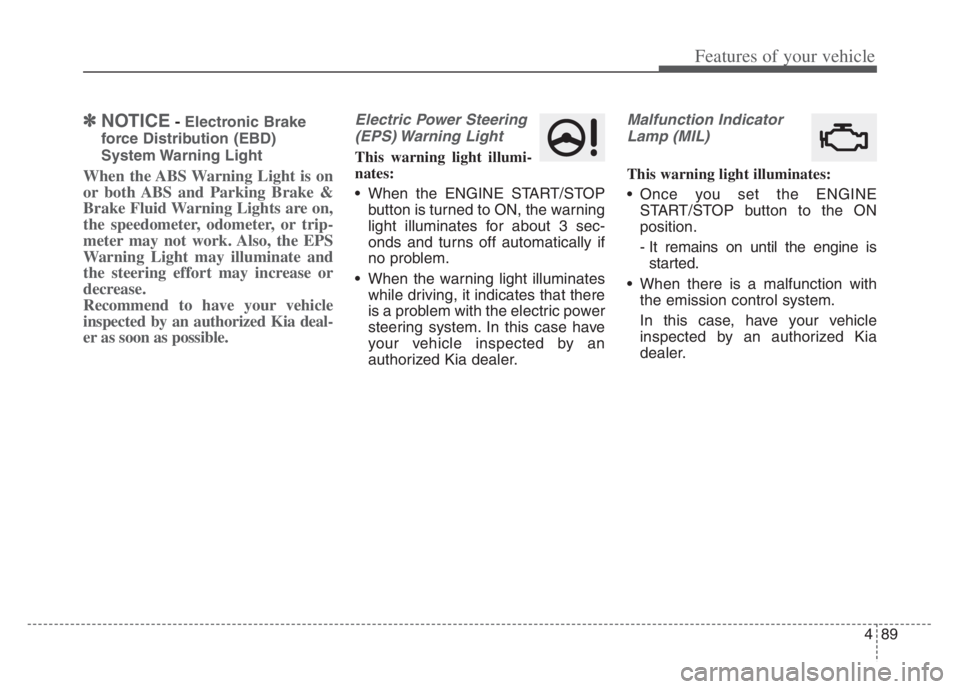
489
Features of your vehicle
✽ ✽
NOTICE- Electronic Brake
force Distribution (EBD)
System Warning Light
When the ABS Warning Light is on
or both ABS and Parking Brake &
Brake Fluid Warning Lights are on,
the speedometer, odometer, or trip-
meter may not work. Also, the EPS
Warning Light may illuminate and
the steering effort may increase or
decrease.
Recommend to have your vehicle
inspected by an authorized Kia deal-
er as soon as possible.
Electric Power Steering
(EPS) Warning Light
This warning light illumi-
nates:
When the ENGINE START/STOP
button is turned to ON, the warning
light illuminates for about 3 sec-
onds and turns off automatically if
no problem.
When the warning light illuminates
while driving, it indicates that there
is a problem with the electric power
steering system. In this case have
your vehicle inspected by an
authorized Kia dealer.
Malfunction Indicator
Lamp (MIL)
This warning light illuminates:
Once you set the ENGINE
START/STOP button to the ON
position.
- It remains on until the engine is
started.
When there is a malfunction with
the emission control system.
In this case, have your vehicle
inspected by an authorized Kia
dealer.
Page 186 of 560
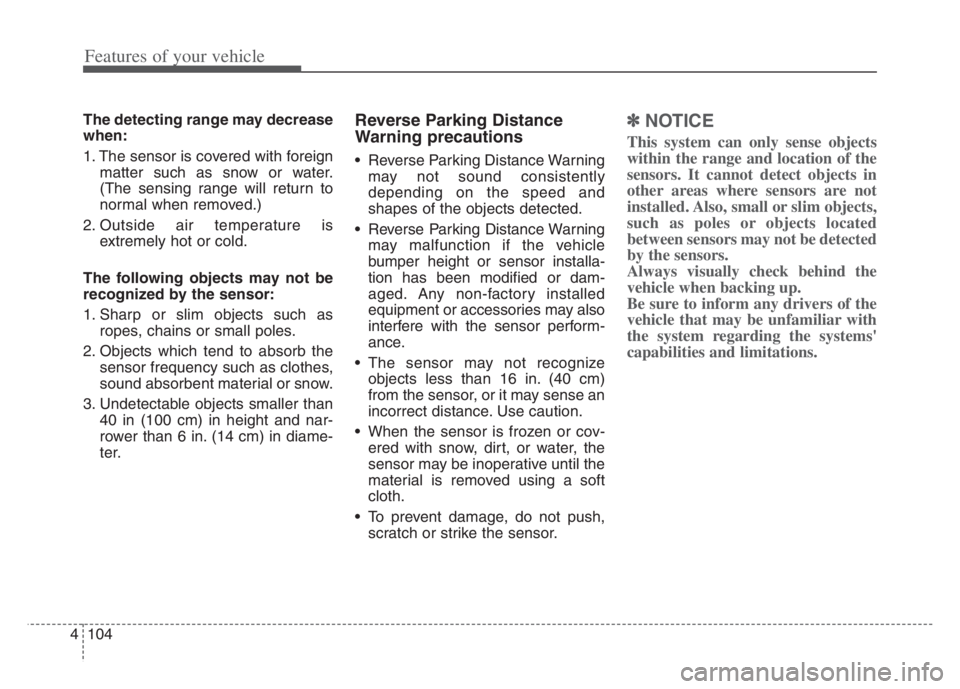
Features of your vehicle
104 4
The detecting range may decrease
when:
1. The sensor is covered with foreign
matter such as snow or water.
(The sensing range will return to
normal when removed.)
2. Outside air temperature is
extremely hot or cold.
The following objects may not be
recognized by the sensor:
1. Sharp or slim objects such as
ropes, chains or small poles.
2. Objects which tend to absorb the
sensor frequency such as clothes,
sound absorbent material or snow.
3. Undetectable objects smaller than
40 in (100 cm) in height and nar-
rower than 6 in. (14 cm) in diame-
ter.Reverse Parking Distance
Warning precautions
Reverse Parking Distance Warning
may not sound consistently
depending on the speed and
shapes of the objects detected.
Reverse Parking Distance Warning
may malfunction if the vehicle
bumper height or sensor installa-
tion has been modified or dam-
aged. Any non-factory installed
equipment or accessories may also
interfere with the sensor perform-
ance.
The sensor may not recognize
objects less than 16 in. (40 cm)
from the sensor, or it may sense an
incorrect distance. Use caution.
When the sensor is frozen or cov-
ered with snow, dirt, or water, the
sensor may be inoperative until the
material is removed using a soft
cloth.
To prevent damage, do not push,
scratch or strike the sensor.
✽ ✽
NOTICE
This system can only sense objects
within the range and location of the
sensors. It cannot detect objects in
other areas where sensors are not
installed. Also, small or slim objects,
such as poles or objects located
between sensors may not be detected
by the sensors.
Always visually check behind the
vehicle when backing up.
Be sure to inform any drivers of the
vehicle that may be unfamiliar with
the system regarding the systems'
capabilities and limitations.
Page 254 of 560
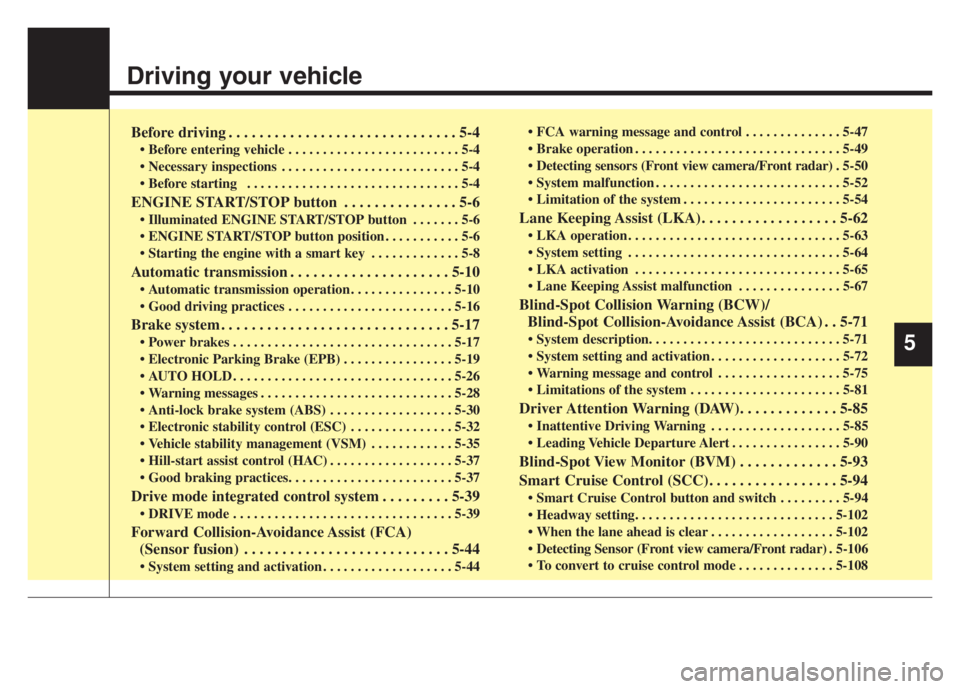
Driving your vehicle
Before driving . . . . . . . . . . . . . . . . . . . . . . . . . . . . . . 5-4
• Before entering vehicle . . . . . . . . . . . . . . . . . . . . . . . . . 5-4
• Necessary inspections . . . . . . . . . . . . . . . . . . . . . . . . . . 5-4
• Before starting . . . . . . . . . . . . . . . . . . . . . . . . . . . . . . . 5-4
ENGINE START/STOP button . . . . . . . . . . . . . . . 5-6
• Illuminated ENGINE START/STOP button . . . . . . . 5-6
• ENGINE START/STOP button position . . . . . . . . . . . 5-6
• Starting the engine with a smart key . . . . . . . . . . . . . 5-8
Automatic transmission . . . . . . . . . . . . . . . . . . . . . 5-10
• Automatic transmission operation . . . . . . . . . . . . . . . 5-10
• Good driving practices . . . . . . . . . . . . . . . . . . . . . . . . 5-16
Brake system . . . . . . . . . . . . . . . . . . . . . . . . . . . . . . 5-17
• Power brakes . . . . . . . . . . . . . . . . . . . . . . . . . . . . . . . . 5-17
• Electronic Parking Brake (EPB) . . . . . . . . . . . . . . . . 5-19
• AUTO HOLD . . . . . . . . . . . . . . . . . . . . . . . . . . . . . . . . 5-26
• Warning messages . . . . . . . . . . . . . . . . . . . . . . . . . . . . 5-28
• Anti-lock brake system (ABS) . . . . . . . . . . . . . . . . . . 5-30
• Electronic stability control (ESC) . . . . . . . . . . . . . . . 5-32
• Vehicle stability management (VSM) . . . . . . . . . . . . 5-35
• Hill-start assist control (HAC) . . . . . . . . . . . . . . . . . . 5-37
• Good braking practices. . . . . . . . . . . . . . . . . . . . . . . . 5-37
Drive mode integrated control system . . . . . . . . . 5-39
• DRIVE mode . . . . . . . . . . . . . . . . . . . . . . . . . . . . . . . . 5-39
Forward Collision-Avoidance Assist (FCA)
(Sensor fusion) . . . . . . . . . . . . . . . . . . . . . . . . . . . 5-44
• System setting and activation . . . . . . . . . . . . . . . . . . . 5-44 •
FCA warning message and control . . . . . . . . . . . . . . 5-47
• Brake operation . . . . . . . . . . . . . . . . . . . . . . . . . . . . . . 5-49
• Detecting sensors (Front view camera/Front radar) . 5-50
• System malfunction . . . . . . . . . . . . . . . . . . . . . . . . . . . 5-52
• Limitation of the system . . . . . . . . . . . . . . . . . . . . . . . 5-54
Lane Keeping Assist (LKA). . . . . . . . . . . . . . . . . . 5-62
• LKA operation . . . . . . . . . . . . . . . . . . . . . . . . . . . . . . . 5-63
• System setting . . . . . . . . . . . . . . . . . . . . . . . . . . . . . . . 5-64
• LKA activation . . . . . . . . . . . . . . . . . . . . . . . . . . . . . . 5-65
• Lane Keeping Assist malfunction . . . . . . . . . . . . . . . 5-67
Blind-Spot Collision Warning (BCW)/
Blind-Spot Collision-Avoidance Assist (BCA) . . 5-71
• System description. . . . . . . . . . . . . . . . . . . . . . . . . . . . 5-71
• System setting and activation . . . . . . . . . . . . . . . . . . . 5-72
• Warning message and control . . . . . . . . . . . . . . . . . . 5-75
• Limitations of the system . . . . . . . . . . . . . . . . . . . . . . 5-81
Driver Attention Warning (DAW). . . . . . . . . . . . . 5-85
• Inattentive Driving Warning . . . . . . . . . . . . . . . . . . . 5-85
• Leading Vehicle Departure Alert . . . . . . . . . . . . . . . . 5-90
Blind-Spot View Monitor (BVM) . . . . . . . . . . . . . 5-93
Smart Cruise Control (SCC). . . . . . . . . . . . . . . . . 5-94
• Smart Cruise Control button and switch . . . . . . . . . 5-94
• Headway setting. . . . . . . . . . . . . . . . . . . . . . . . . . . . . 5-102
• When the lane ahead is clear . . . . . . . . . . . . . . . . . . 5-102
• Detecting Sensor (Front view camera/Front radar) . 5-106
• To convert to cruise control mode . . . . . . . . . . . . . . 5-108
5
Page 283 of 560
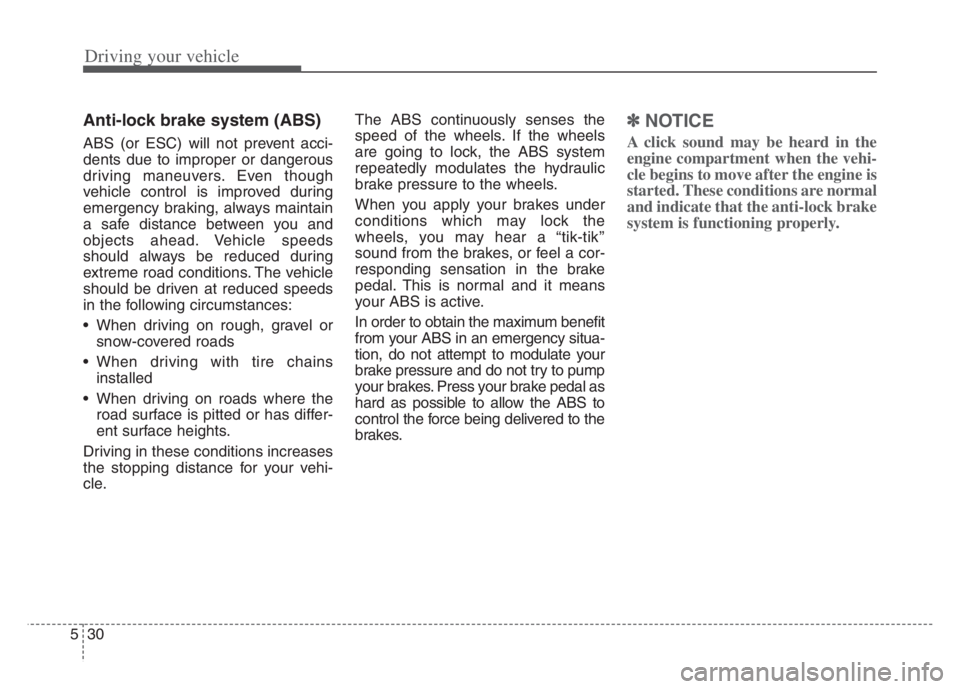
Driving your vehicle
30 5
Anti-lock brake system (ABS)
ABS (or ESC) will not prevent acci-
dents due to improper or dangerous
driving maneuvers. Even though
vehicle control is improved during
emergency braking, always maintain
a safe distance between you and
objects ahead. Vehicle speeds
should always be reduced during
extreme road conditions. The vehicle
should be driven at reduced speeds
in the following circumstances:
When driving on rough, gravel or
snow-covered roads
When driving with tire chains
installed
When driving on roads where the
road surface is pitted or has differ-
ent surface heights.
Driving in these conditions increases
the stopping distance for your vehi-
cle.The ABS continuously senses the
speed of the wheels. If the wheels
are going to lock, the ABS system
repeatedly modulates the hydraulic
brake pressure to the wheels.
When you apply your brakes under
conditions which may lock the
wheels, you may hear a “tik-tik’’
sound from the brakes, or feel a cor-
responding sensation in the brake
pedal. This is normal and it means
your ABS is active.
In order to obtain the maximum benefit
from your ABS in an emergency situa-
tion, do not attempt to modulate your
brake pressure and do not try to pump
your brakes. Press your brake pedal as
hard as possible to allow the ABS to
control the force being delivered to the
brakes.
✽ ✽
NOTICE
A click sound may be heard in the
engine compartment when the vehi-
cle begins to move after the engine is
started. These conditions are normal
and indicate that the anti-lock brake
system is functioning properly.
Page 284 of 560
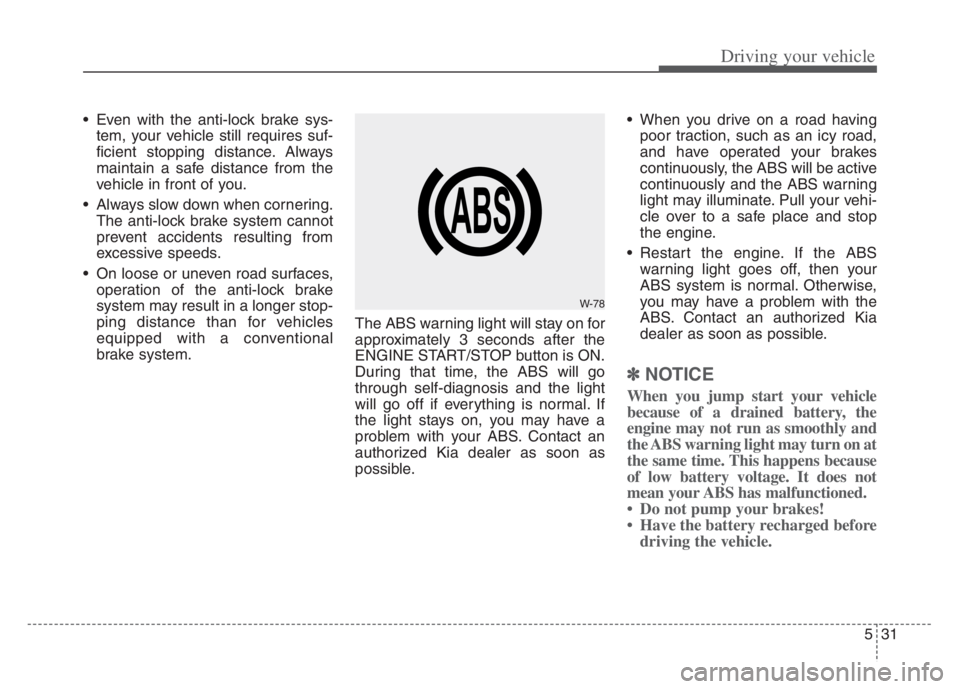
531
Driving your vehicle
Even with the anti-lock brake sys-
tem, your vehicle still requires suf-
ficient stopping distance. Always
maintain a safe distance from the
vehicle in front of you.
Always slow down when cornering.
The anti-lock brake system cannot
prevent accidents resulting from
excessive speeds.
On loose or uneven road surfaces,
operation of the anti-lock brake
system may result in a longer stop-
ping distance than for vehicles
equipped with a conventional
brake system.The ABS warning light will stay on for
approximately 3 seconds after the
ENGINE START/STOP button is ON.
During that time, the ABS will go
through self-diagnosis and the light
will go off if everything is normal. If
the light stays on, you may have a
problem with your ABS. Contact an
authorized Kia dealer as soon as
possible. When you drive on a road having
poor traction, such as an icy road,
and have operated your brakes
continuously, the ABS will be active
continuously and the ABS warning
light may illuminate. Pull your vehi-
cle over to a safe place and stop
the engine.
Restart the engine. If the ABS
warning light goes off, then your
ABS system is normal. Otherwise,
you may have a problem with the
ABS. Contact an authorized Kia
dealer as soon as possible.
✽ ✽
NOTICE
When you jump start your vehicle
because of a drained battery, the
engine may not run as smoothly and
the ABS warning light may turn on at
the same time. This happens because
of low battery voltage. It does not
mean your ABS has malfunctioned.
• Do not pump your brakes!
• Have the battery recharged before
driving the vehicle.
W-78
Page 288 of 560

535
Driving your vehicle
ESC OFF usage
When driving
ESC should be turned on for daily
driving whenever possible.
To turn ESC off while driving, press
the ESC OFF button while driving
on a flat road surface.
✽ ✽
NOTICE
• When operating the vehicle on a
dynamometer, ensure that the
ESC is turned off (ESC OFF light
illuminated). If the ESC is left on,
it may prevent the vehicle speed
from increasing, and result in false
diagnosis.
• Turning the ESC off does not affect
ABS or brake system operation.
Vehicle stability management
(VSM)
This system provides further
enhancements to vehicle stability
and steering responses when a vehi-
cle is driving on a slippery road or a
vehicle detects changes in coeffi-
cient of friction between right wheels
and left wheels when braking.
WARNING- Operating
ESC
Never press the ESC OFF but-
ton while ESC is operating (ESC
indicator light blinks).
If ESC is turned off while ESC is
operating, the vehicle may slip
out of control.
WARNING- Tire/
Wheel size
When replacing tires and wheels,
make sure they are the same size
as the original tires and wheels
installed. Driving with varying
tire or wheel sizes may diminish
any supplemental safety benefits
of the VSM system.WARNING- Electronic sta-
bility control
Drive carefully even though your
vehicle has Electronic Stability
Control. It can only assist you in
maintaining control under cer-
tain circumstances.
CAUTION
Driving with varying tire or
wheel sizes may cause the ESC
system to malfunction. When
replacing tires, make sure they
are the same size as your origi-
nal tires.
Page 349 of 560

Driving your vehicle
96 5
SCC Not Operating Conditions
The driver’s door is opened.
The vehicle is shifted to N (Neutral)
/ R (Reverse) / P (Parking).
The parking brake is applied.
The vehicle speed is not within the
specified SCC range.
The ESC (Electronic Stability
Control), TCS (Traction Control
System)or ABS is operating. The ESC (Electronic Stability
Control), TCS (Traction Control
System)or ABS is off.
The ESC (Electronic Stability
Control), TCS (Traction Control
System)or ABS is operating.
The sensor cover is extremely con-
taminated.
The engine performance is abnor-
mal.
Forward Collision-Avoidance
Assist is activated.
The engine RPM is in the red zone.
The front radar is abnormal.
To increase Smart Cruise Control
set speed:
Follow either of these procedures:
Move the RES+ switch up, and
hold it. Your vehicle set speed will
increase by 5 mph (10 km/h).
Release the switch at the speed
you want.
Move the RES+ switch up, and
release it immediately. The cruising
speed will increase by 1.0 mph (1.0
km/h) each time you move the
RES+ switch up in this manner.
OYG059346L
OYG059039
Page 351 of 560
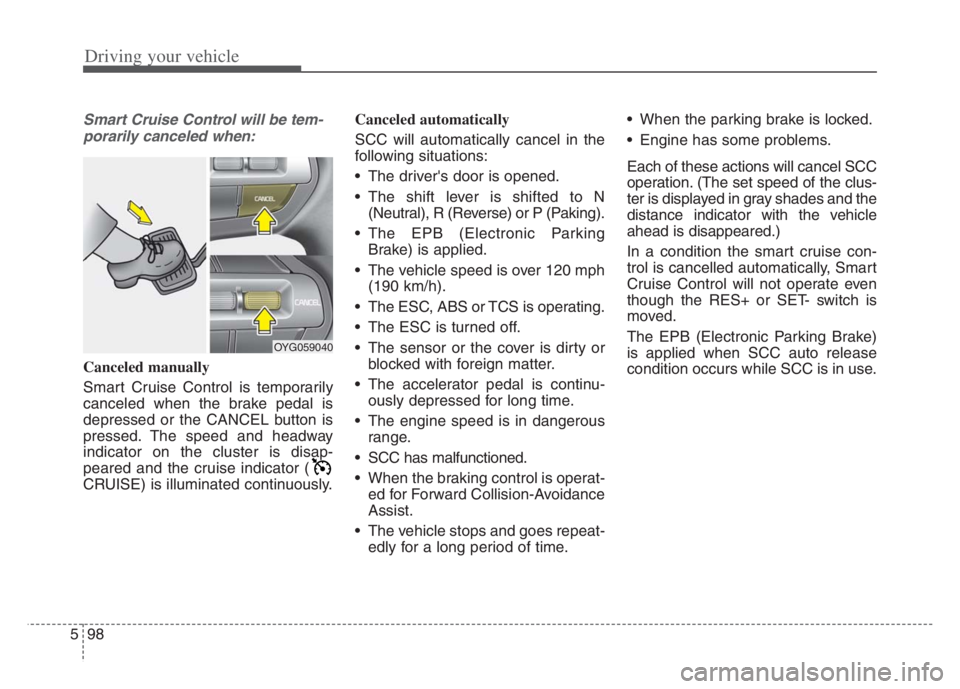
Driving your vehicle
98
5
Smart Cruise Control will be tem-
porarily canceled when:
Canceled manually
Smart Cruise Control is temporarily
canceled when the brake pedal is
depressed or the CANCEL button is
pressed. The speed and headway
indicator on the cluster is disap-
peared and the cruise indicator (
CRUISE) is illuminated continuously. Canceled automatically
SCC will automatically cancel in the
following situations:
The driver's door is opened.
The shift lever is shifted to N
(Neutral), R (Reverse) or P (Paking).
The EPB (Electronic Parking Brake) is applied.
The vehicle speed is over 120 mph (190 km/h).
The ESC, ABS or TCS is operating.
The ESC is turned off.
The sensor or the cover is dirty or blocked with foreign matter.
The accelerator pedal is continu- ously depressed for long time.
The engine speed is in dangerous range.
SCC has malfunctioned.
When the braking control is operat- ed for Forward Collision-Avoidance
Assist.
The vehicle stops and goes repeat- edly for a long period of time. When the parking brake is locked.
Engine has some problems.
Each of these actions will cancel SCC
operation. (The set speed of the clus-
ter is displayed in gray shades and the
distance indicator with the vehicle
ahead is disappeared.)
In a condition the smart cruise con-
trol is cancelled automatically, Smart
Cruise Control will not operate even
though the RES+ or SET- switch is
moved.
The EPB (Electronic Parking Brake)
is applied when SCC auto release
condition occurs while SCC is in use.
OYG059040
Page 404 of 560
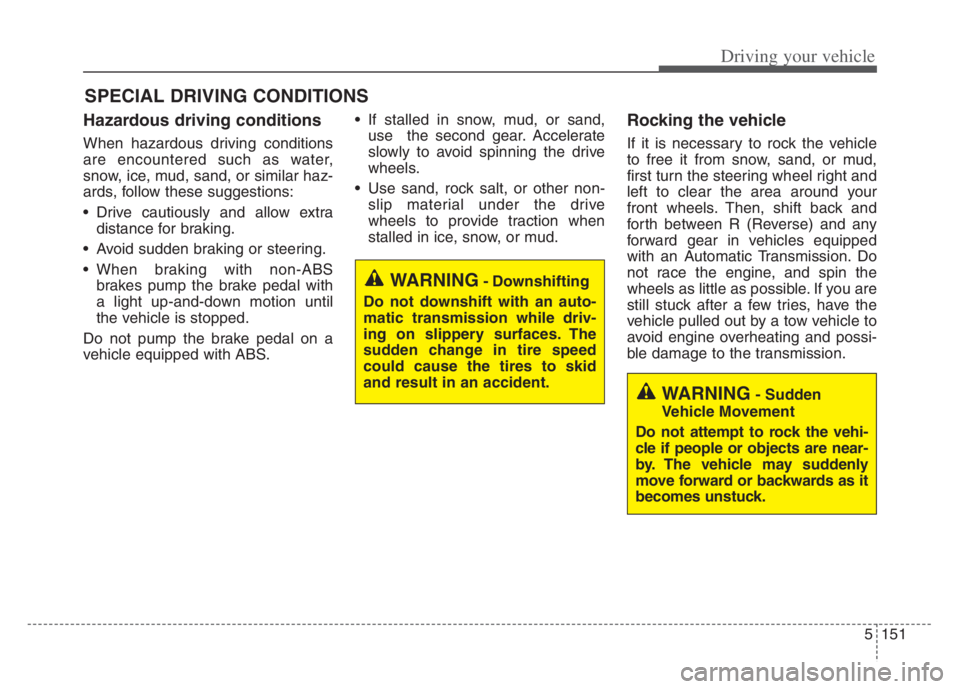
5151
Driving your vehicle
Hazardous driving conditions
When hazardous driving conditions
are encountered such as water,
snow, ice, mud, sand, or similar haz-
ards, follow these suggestions:
Drive cautiously and allow extra
distance for braking.
Avoid sudden braking or steering.
When braking with non-ABS
brakes pump the brake pedal with
a light up-and-down motion until
the vehicle is stopped.
Do not pump the brake pedal on a
vehicle equipped with ABS. If stalled in snow, mud, or sand,
use the second gear. Accelerate
slowly to avoid spinning the drive
wheels.
Use sand, rock salt, or other non-
slip material under the drive
wheels to provide traction when
stalled in ice, snow, or mud.
Rocking the vehicle
If it is necessary to rock the vehicle
to free it from snow, sand, or mud,
first turn the steering wheel right and
left to clear the area around your
front wheels. Then, shift back and
forth between R (Reverse) and any
forward gear in vehicles equipped
with an Automatic Transmission. Do
not race the engine, and spin the
wheels as little as possible. If you are
still stuck after a few tries, have the
vehicle pulled out by a tow vehicle to
avoid engine overheating and possi-
ble damage to the transmission.
SPECIAL DRIVING CONDITIONS
WARNING- Downshifting
Do not downshift with an auto-
matic transmission while driv-
ing on slippery surfaces. The
sudden change in tire speed
could cause the tires to skid
and result in an accident.
WARNING- Sudden
Vehicle Movement
Do not attempt to rock the vehi-
cle if people or objects are near-
by. The vehicle may suddenly
move forward or backwards as it
becomes unstuck.